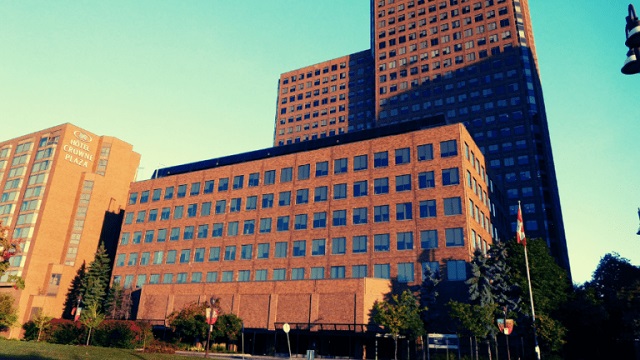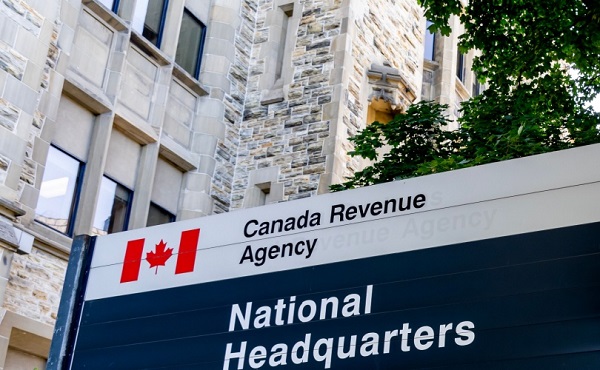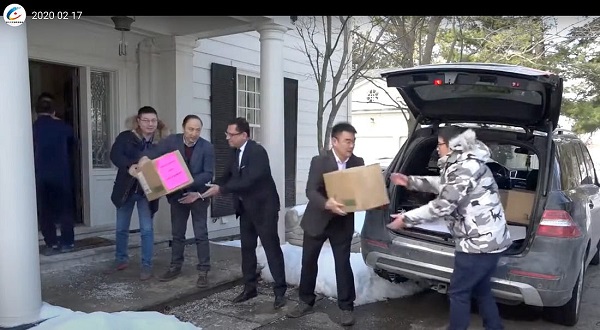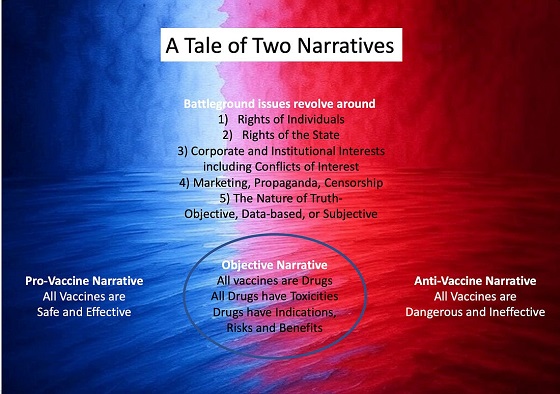Business
A tiny spark of hope in another soul-crushing round of CRTC hearings: Peter Menzies

From the MacDonald Laurier Institute
By Peter Menzies
It was as if the internet — the most democratizing, weird, wonderful, frightening and important technological development in communications since the printing press — had never been invented.
Earlier this month, halfway through answering a question from the House of Commons Industry committee, Annette Verschusen abruptly removed her headphones, stood up, unplugged, and walked out.
It was shocking.
And yet, in a rascally sort of way, I admired it. Yes, yes, the former head of Home Depot Canada and the chancellor of Cape Breton University recently had to resign as chair of Sustainable Development Technology Canada and is under investigation by the Ethics Commissioner for approving hundreds of thousands of dollars in Green Fund grants to her own company, NRStor Inc. But still, who among us hasn’t fantasized about acting out in similar fashion when the blinding light of revelation strikes and it suddenly dawns on you: “WTF am I even doing here? I don’t need this shit.”
And, in your fantasy, you just get up and leave. Like Verschusen did.
I confess I once harboured a similar impulse towards the end of an arduous Canadian Radio-television and Telecommunications Commission (CRTC) hearing along the lines of the three-week-long epic that concluded Dec. 8.
Part of my despair was likely due to being tired. Everyone who appears before a CRTC panel (I was a Commissioner for a decade) deserves one’s full attention and there are thousands of pages of required reading in the weeks leading up to and in the evenings during a hearing.
Then there’s the hearing room. Seemingly designed by Dante Alighieri to sap the will to live from those condemned to work within it, the room’s about the size of an elementary school gym. There are no windows or art and the ambiance complements the soulless mid-century Soviet architectural style of Gatineau’s public buildings.
But — and I hesitate to confess this — it was the relentless rent-seeking that made my mind wander during breaks and impishly imagine what would happen if I just unplugged my laptop, got up, walked out through the crowds, got a cab straight to the airport and never came back. Because eventually, most CRTC hearings devolve into two broad categories. One is a series of presentations from large, protected and profitable companies explaining the dire consequences if they don’t get their way. The other is a seemingly endless parade of well-meaning groups begging for the large companies’ money lest their roles as cultural saviours are diminished. It’s predictably tiresome, tedious and exhausting. But the stakeholders know that commissioners come and go on a regular basis, so no cause to worry about them getting wise to the game.
I was reminded of that inappropriate thought while monitoring the final week of this most recent hearing. When I wasn’t watching, I was reading transcripts and experiencing it all in a mildly PTSDish sort of way.
This hearing was the first of three scheduled to implement the Online Streaming Act (Bill C-11) which amended the Broadcasting Act for the first time since 1991 in order to “modernize” it by — absurdly, in my view — defining the internet as broadcasting and putting it lock, stock and barrel under the authority of the CRTC, which was first formed in 1968 to make sure Anne Murray and Terry Jacks got fair play on the radio airwaves.
This first phase — in which offshore streamers such as Netflix and Disney+ made their regulatory debut — was supposed to be about three things:
- Defining the cutoff line — $10 million, $25 million or $50 million in annual revenue — the CRTC would use to study which companies must buck up and fund Canadian content;
- Deciding how much those companies would have to pay;
- Determining how many different funds should get the loot and how many groups would be involved — BIPOC, Indigenous, LGBTQ2S, etc.
It wasn’t the debilitating boredom of it all that was the most difficult to overcome. Nor was it the acronym-laden banter between the panel and stakeholders that rendered the discourse incomprehensible to ordinary Canadians. And while the manner in which consumers’ interests were disregarded was beyond frustrating, that wasn’t the worst part.
The seriously soul-crushing aspect was that this hearing looked, sounded and felt exactly like CRTC broadcasting hearings have looked, sounded and felt for 30 years.
It was as if the internet — the most democratizing, weird, wonderful, frightening and important technological development in communications since the printing press — had never been invented.
It was a funereal procession of grim-faced presenters from large, often outrageously profitable domestic companies involved in providing telephone, mobile, internet, cable and broadcasting crying woe are we, declaring the industry to be in “crisis,” demanding “urgent” relief from their regulatory burdens and threatening the jobs of thousands of workers should they not get their way. They even got the ball rolling on a whole new fund for local news production lest democracy die. Because, without them, of course it will.
This was followed by a chorus line of vested interests explaining how important it is for the regulator to ensure lotsa cash flows in their direction lest the nation’s creative aesthetic dies under the jackboot of American cultural imperialism. And — OMG! — whatever happens don’t make me have to move to Hollywood. You know, like poor old Ryan Reynolds did.
There were, to be fair, bright parts when the companies and workers that have built success on the internet politely explained, with respect, that what the CRTC was talking about makes no sense in 2023. None whatsoever. Some even begged the panel of Commissioners to please “do no harm.”
Welcome as something — anything — “modern” was during what otherwise was a bad acid flashback to decades past, it was not enough to revive any sense of optimism. At least not until YouTuber J.J. McCullough — the penultimate presenter — showed up.
In words everyone can understand, he said that we are in “a time when there’s a huge thriving sort of forward‑looking modern youthful wing of the Canadian cultural economy and cultural space in the form of online content creators who are often very entrepreneurial, very self‑directed people that have started from very little and have become very successful.”
And that there is concern with “the idea that those people are perhaps in some way like a problem that now needs to be solved in order to sort of subsidize people that, you know, god bless them, are sort of clinging to perhaps a dream of success in a medium that there just isn’t market or public demand for any more.”
It offered a small flicker of hope that, somehow, the 21st century and all its possibilities might yet survive the CRTC’s smothering embrace.
Then again, as the saying goes, it’s the hope that kills you.
Peter Menzies is a senior fellow with the Macdonald-Laurier Institute, past vice-chair of the CRTC and a former newspaper publisher.
Education
Schools should focus on falling math and reading grades—not environmental activism

From the Fraser Institute
In 2019 Toronto District School Board (TDSB) trustees passed a “climate emergency” resolution and promised to develop a climate action plan. Not only does the TDSB now have an entire department in their central office focused on this goal, but it also publishes an annual climate action report.
Imagine you were to ask a random group of Canadian parents to describe the primary mission of schools. Most parents would say something along the lines of ensuring that all students learn basic academic skills such as reading, writing and mathematics.
Fewer parents are likely to say that schools should focus on reducing their environmental footprints, push students to engage in environmental activism, or lobby for Canada to meet the 2016 Paris Agreement’s emission-reduction targets.
And yet, plenty of school boards across Canada are doing exactly that. For example, the Seven Oaks School Division in Winnipeg is currently conducting a comprehensive audit of its environmental footprint and intends to develop a climate action plan to reduce its footprint. Not only does Seven Oaks have a senior administrator assigned to this responsibility, but each of its 28 schools has a designated climate action leader.
Other school boards have gone even further. In 2019 Toronto District School Board (TDSB) trustees passed a “climate emergency” resolution and promised to develop a climate action plan. Not only does the TDSB now have an entire department in their central office focused on this goal, but it also publishes an annual climate action report. The most recent report is 58 pages long and covers everything from promoting electric school buses to encouraging schools to gain EcoSchools certification.
Not to be outdone, the Vancouver School District (VSD) recently published its Environmental Sustainability Plan, which highlights the many green initiatives in its schools. This plan states that the VSD should be the “greenest, most sustainable school district in North America.”
Some trustees want to go even further. Earlier this year, the British Columbia School Trustees Association released its Climate Action Working Group report that calls on all B.C. school districts to “prioritize climate change mitigation and adopt sustainable, impactful strategies.” It also says that taking climate action must be a “core part” of school board governance in every one of these districts.
Apparently, many trustees and school board administrators think that engaging in climate action is more important than providing students with a solid academic education. This is an unfortunate example of misplaced priorities.
There’s an old saying that when everything is a priority, nothing is a priority. Organizations have finite resources and can only do a limited number of things. When schools focus on carbon footprint audits, climate action plans and EcoSchools certification, they invariably spend less time on the nuts and bolts of academic instruction.
This might be less of a concern if the academic basics were already understood by students. But they aren’t. According to the most recent data from the Programme for International Student Assessment (PISA), the math skills of Ontario students declined by the equivalent of nearly two grade levels over the last 20 years while reading skills went down by about half a grade level. The downward trajectory was even sharper in B.C., with a more than two grade level decline in math skills and a full grade level decline in reading skills.
If any school board wants to declare an emergency, it should declare an academic emergency and then take concrete steps to rectify it. The core mandate of school boards must be the education of their students.
For starters, school boards should promote instructional methods that improve student academic achievement. This includes using phonics to teach reading, requiring all students to memorize basic math facts such as the times table, and encouraging teachers to immerse students in a knowledge-rich learning environment.
School boards should also crack down on student violence and enforce strict behaviour codes. Instead of kicking police officers out of schools for ideological reasons, school boards should establish productive partnerships with the police. No significant learning will take place in a school where students and teachers are unsafe.
Obviously, there’s nothing wrong with school boards ensuring that their buildings are energy efficient or teachers encouraging students to take care of the environment. The problem arises when trustees, administrators and teachers lose sight of their primary mission. In the end, schools should focus on academics, not environmental activism.
2025 Federal Election
Conservative MP Leslyn Lewis warns Canadian voters of Liberal plan to penalize religious charities

From LifeSiteNews
A Liberal government plan for pro-life and religious groups to be stripped of their tax charity status is an ‘assault’ on people’s faith, MP Leslyn Lewis said.
Canadian Conservative pro-life MP Leslyn Lewis said a plan supported by Mark Carney’s Liberal government that calls for pro-life and religious groups to be stripped of their tax charity status should be an election issue as it’s an “assault” on people’s faith.
“The Liberal plan to revoke the charitable status of religious organizations is an assault on people of faith across Canada,” Lewis wrote on X last week.
Lewis linked her post to an opinion piece published in the Niagara Independent by Lee Harding with the headline “Canada’s sleeper election issue: the loss of charitable status for religious organizations.”
Harding observed that the “potential loss of charitable status for religious charities might be the biggest sleeper issue in the federal election.”
“The Liberal government proposed the change and only Conservatives opposed,” Harding said.
Lewis noted that 40 percent of the 85,600 charities in Canada are religious organizations.
“These are organizations that feed the hungry, support the elderly, rally around people in crisis, provide addiction recovery services – and this is just the tip of the iceberg,” she wrote.
“It is quite honestly disgusting that the Liberals would try to sneak in this unconscionable attack in a Finance Committee report, just before Parliament prorogued.”
She noted how a recent Cardus study shows that if these charities lose their tax status “Canadians would lose $16.5B in services.”
Canadians will head to the polls on April 28. Harding noted how “One needn’t be religious to see the harm in such uncharitable changes to Canada’s charitable sector.”
“Fortunately, Canadians can vote down this misguided attack on religious charities. Whether they do so is up to them.”
Last month, the Conservative Party of Canada launched a petition blasting a recent finance committee recommendation supported by Carney that calls for pro-life and religious groups to have their charity tax status revoked.
The Finance Committee’s pre-budget report proposal released in December 2024 by the all-party Finance Committee suggested that legislation is needed to strip pro-life pregnancy centers and religious groups of their charitable status.
The legislation would amend the Income Tax Act and Income Tax. Section 429 of the proposed legislation recommends the government “no longer provide charitable status to anti-abortion organizations.”
All federal parties except for the Conservatives under Pierre Poilievre support the finance report’s recommendation.
Canada’s Catholic bishops have blasted the report’s recommendations and have urged the Liberal federal government to not proceed with any legislation that would target pro-life groups of religious organizations’ charity tax status.
The good news is that in light of former Prime Minister Justin Trudeau’s shutting of Parliament in order to step down from office, already planned legislation to strip pro-life pregnancy centers of charity status is on pause, at least for now.
Despite the reality that Poilievre is also pro-abortion, the former Trudeau now Carney Liberal government has in recent months ramped up his abortion rhetoric on social media in a seeming bid to rally its base, consistently boasting about his government’s desire to make killing a child in the womb easier than ever. Trudeau also repeatedly bragged about his pro-abortion record in the House of Commons.
-

 2025 Federal Election2 days ago
2025 Federal Election2 days agoPPE Videos, CCP Letters Reveal Pandemic Coordination with Liberal Riding Boss and Former JCCC Leader—While Carney Denies Significant Meeting In Campaign
-

 2025 Federal Election1 day ago
2025 Federal Election1 day agoNo Matter The Winner – My Canada Is Gone
-

 2025 Federal Election1 day ago
2025 Federal Election1 day agoASK YOURSELF! – Can Canada Endure, or Afford the Economic Stagnation of Carney’s Costly Climate Vision?
-

 Alberta1 day ago
Alberta1 day agoMade in Alberta! Province makes it easier to support local products with Buy Local program
-

 Alberta1 day ago
Alberta1 day agoProvince to expand services provided by Alberta Sheriffs: New policing option for municipalities
-

 2025 Federal Election1 day ago
2025 Federal Election1 day agoCSIS Warned Beijing Would Brand Conservatives as Trumpian. Now Carney’s Campaign Is Doing It.
-

 2025 Federal Election1 day ago
2025 Federal Election1 day agoInside Buttongate: How the Liberal Swamp Tried to Smear the Conservative Movement — and Got Exposed
-

 Dr. Robert Malone20 hours ago
Dr. Robert Malone20 hours agoThe West Texas Measles Outbreak as a Societal and Political Mirror






